
Hymns in Prose for Children (1781) is a children's book by Anna Laetitia Barbauld.

Hymns in Prose for Children (1781) is a children's book by Anna Laetitia Barbauld.
Barbauld and her husband were concerned that they would never have a child of their own and in 1775, after only a year of marriage, Barbauld suggested to her brother, John Aikin, that they adopt one of his children:
I am sensible it is not a small thing we ask; nor can it be easy for a parent to part with a child. This I would say, from a number, one may more easily be spared. Though it makes a very material difference in happiness whether a person has children or no children, it makes, I apprehend, little or none whether he has three, or four; five, or six; because four or five are enow [ sic ] to exercise all his whole stock of care and affection. We should gain, but you would not lose. [1]
Eventually her brother conceded and the couple adopted Charles; it was for him that Barbauld wrote her most famous books: Lessons for Children (1778–9) and Hymns in Prose for Children (1781).
Barbauld’s Lessons for Children and Hymns in Prose for Children were a revolution in children’s literature. For the first time, the needs of the child reader were seriously considered. Barbauld demanded that her books be printed in large type with wide margins so that children could easily read them and, even more importantly, she developed a style of “informal dialogue between parent and child” that would dominate children’s literature for a generation. [2]
Lessons for Children and Hymns in Prose had, for children’s books, an unprecedented impact; not only did they influence the poetry of William Blake and William Wordsworth, [3] they were also used to teach several generations of school children. Although both Samuel Johnson and Charles James Fox ridiculed Barbauld’s children’s books and believed that she was wasting her talents, [4] Barbauld herself believed that such writing was noble and she encouraged others to follow in her footsteps. As Betsy Rodgers, her biographer explains, “she gave prestige to the writing of juvenile literature, and by not lowering her standard of writing for children, she inspired others to write on a similar high standard.” [5] In fact, because of Barbauld, Sarah Trimmer and Hannah More were inspired to write for poor children as well as organize a large-scale Sunday School movement, Ellenor Fenn wrote and designed a series of readers and games for middle-class children and Richard Lovell Edgeworth began one of the first systematic studies of childhood development which would culminate in not only an educational treatise authored by Maria Edgeworth and himself but also in a large body of children’s stories by Maria herself. [6]

Maria Edgeworth was a prolific Anglo-Irish novelist of adults' and children's literature. She was one of the first realist writers in children's literature and was a significant figure in the evolution of the novel in Europe. She held views on estate management, politics and education, and corresponded with some of the leading literary and economic writers, including Sir Walter Scott and David Ricardo.
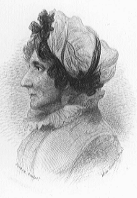
Anna Laetitia Barbauld was a prominent English poet, essayist, literary critic, editor, and author of children's literature. A "woman of letters" who published in multiple genres, Barbauld had a successful writing career that spanned more than half a century.
Lucy Aikin was an English historical writer, biographer and correspondent. She also published under pseudonyms such as Mary Godolphin. Her literary-minded family included her aunt Anna Laetitia Barbauld, a writer of poetry, essays and children's books.

Elizabeth Montagu was a British social reformer, patron of the arts, salonnière, literary critic and writer, who helped to organize and lead the Blue Stockings Society. Her parents were both from wealthy families with strong ties to the British peerage and learned life. She was sister to Sarah Scott, author of A Description of Millenium [sic] Hall and the Country Adjacent. She married Edward Montagu, a man with extensive landholdings, to become one of the richer women of her era. She devoted this fortune to fostering English and Scottish literature and to the relief of the poor.
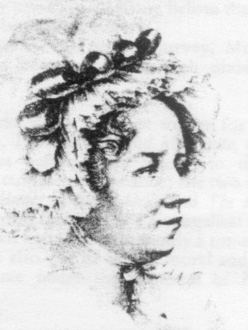
Mary Martha Sherwood was a nineteenth-century English children's writer. Of her more than four hundred works, the best known include The History of Little Henry and his Bearer (1814) and the two series The History of Henry Milner (1822–1837) and The History of the Fairchild Family (1818–1847). Her evangelicalism permeated her early writings, but later works cover common Victorian themes such as domesticity.
Cecil Frances Alexander was an Anglo-Irish hymnwriter and poet. Amongst other works, she wrote "All Things Bright and Beautiful", "There is a green hill far away" and the Christmas carol "Once in Royal David's City".
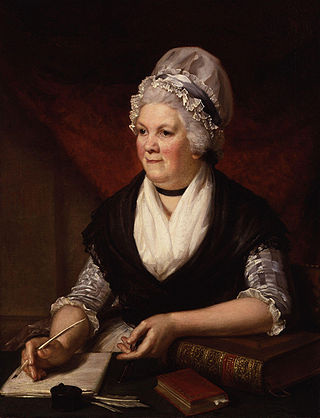
Sarah Trimmer was a writer and critic of 18th-century British children's literature, as well as an educational reformer. Her periodical, The Guardian of Education, helped to define the emerging genre by seriously reviewing children's literature for the first time; it also provided the first history of children's literature, establishing a canon of the early landmarks of the genre that scholars still use today. Trimmer's most popular children's book, Fabulous Histories, inspired numerous children's animal stories and remained in print for over a century.
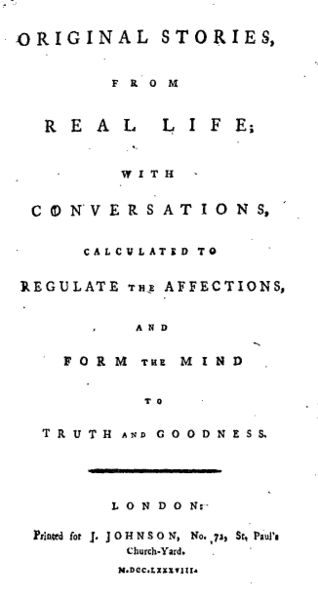
Original Stories from Real Life; with Conversations Calculated to Regulate the Affections, and Form the Mind to Truth and Goodness is the only complete work of children's literature by the 18th-century English feminist author Mary Wollstonecraft. Original Stories begins with a frame story that sketches out the education of two young girls by their maternal teacher Mrs. Mason, followed by a series of didactic tales. The book was first published by Joseph Johnson in 1788; a second, illustrated edition, with engravings by William Blake, was released in 1791 and remained in print for around a quarter of a century.

Evenings at Home, or The Juvenile Budget Opened (1792–1796) is a collection of six volumes of stories written by John Aikin and his sister Anna Laetitia Barbauld. It is an early example of children's literature. The late Victorian children's writer Mary Louisa Molesworth named it as one of the handful of books that was owned by every family in her childhood and read enthusiastically. In their introduction, the authors explain the title in these words:

Ellenor Fenn was a prolific 18th-century British writer of children's books.

Lessons for Children is a series of four age-adapted reading primers written by the prominent 18th-century British poet and essayist Anna Laetitia Barbauld. Published in 1778 and 1779, the books initiated a revolution in children's literature in the Anglo-American world. For the first time, the needs of the child reader were seriously considered: the typographically simple texts progress in difficulty as the child learns. In perhaps the first demonstration of experiential pedagogy in Anglo-American children's literature, Barbauld's books use a conversational style, which depicts a mother and her son discussing the natural world. Based on the educational theories of John Locke, Barbauld's books emphasise learning through the senses.

The Guardian of Education was the first successful periodical dedicated to reviewing children's literature in Britain. It was edited by 18th-century educationalist, children's author, and Sunday school advocate Sarah Trimmer and was published from June 1802 until September 1806 by J. Hatchard and F. C. and J. Rivington. The journal offered child-rearing advice and assessments of contemporary educational theories, and Trimmer even proffered her own educational theory after evaluating the major works of the day.

Hymns for the Amusement of Children (1771) was the final work completed by English poet Christopher Smart. It was completed while Smart was imprisoned for outstanding debt at the King's Bench Prison, and the work is his final exploration of religion. Although Smart spent a large portion of his life in and out of debt, he was unable to survive his time in the prison and died soon after completing the Hymns.
Palgrave Academy was an early dissenting academy, that is, a school or college set up by English Dissenters. It was run from 1774 to 1785 in Palgrave, Suffolk, by the married couple Anna Laetitia Barbauld and her husband Rochemont Barbauld, a minister. The academy attracted parents who wished an alternative to traditional education for their sons.

Divine Songs Attempted in Easy Language for the Use of Children is a collection of didactic, moral poetry for children by Isaac Watts, first published in 1715. Though Watts's hymns are now better known than these poems, Divine Songs was a ubiquitous children's book for nearly two hundred years, serving as a standard textbook in schools. By the mid-19th century there were more than one thousand editions.

Honora Edgeworth was an eighteenth-century English writer, mainly known for her associations with literary figures of the day particularly Anna Seward and the Lunar Society, and for her work on children's education. Sneyd was born in Bath in 1751, and following the death of her mother in 1756 was raised by Canon Thomas Seward and his wife Elizabeth in Lichfield, Staffordshire until she returned to her father's house in 1771. There, she formed a close friendship with their daughter, Anna Seward. Having had a romantic engagement to John André and having declined the hand of Thomas Day, she married Richard Edgeworth as his second wife in 1773, living on the family estate in Ireland till 1776. There she helped raise his children from his first marriage, including Maria Edgeworth, and two children of her own. Returning to England she fell ill with tuberculosis, which was incurable, dying at Weston in Staffordshire in 1780. She is the subject of a number of Anna Seward's poems, and with her husband developed concepts of childhood education, resulting in a series of books, such as Practical Education, based on her observations of the Edgeworth children. She is known for her stand on women's rights through her vigorous rejection of the proposal by Day, in which she outlined her views on equality in marriage.
Rural Walks is an early work of children's literature by Charlotte Turner Smith, first published in 1795. The book was intended to introduce children to both poetry and natural history, partly inspired by Anna Laetitia Barbaulds' Evenings at Home (1792–1796). Like her other educational works for children, it was primarily intended for an audience of girls, since boys would have access to formal schooling which made such books less necessary for them.
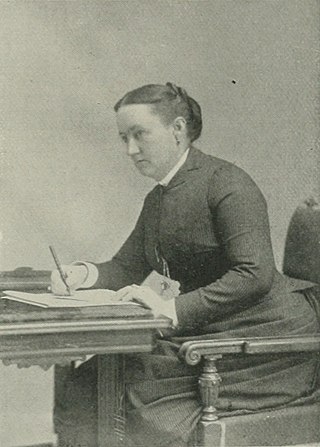
Grace A. Oliver was a 19th-century American author, litterateur, and advocate for women's rights. She was characterized as a woman of rare executive ability, a good speaker, and was noted for her charity work.

Mothers of the Novel: 100 Good Women Writers Before Jane Austen (1986), by Dale Spender, is a foundational study for the reclamation project central to feminist literary studies in English in the late 1980s and 1990s.